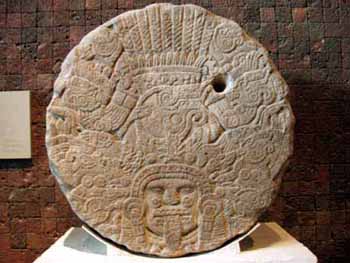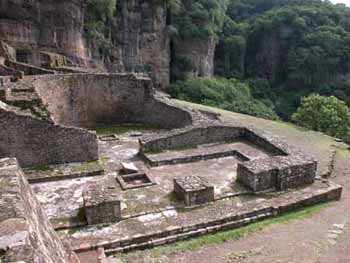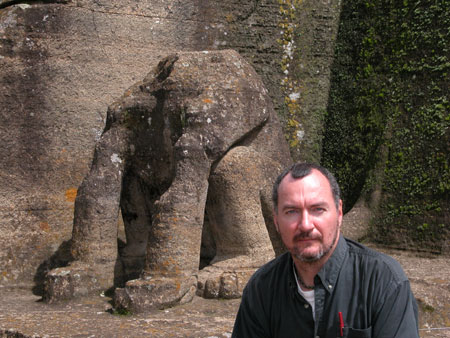| Manuel Aguilar-Moreno AZTEC ART & ARCHITECTURE |
||
Ver este informe en Español. Art A main function of Aztec Art was to express religious and mythical concepts to legitimize the power of the State. This artistic language spoke predominantly through the form of iconographic symbols and metaphors. For example, the image of the eagle symbolized the warrior and the sun at its zenith. Images of serpents were linked to the gods Tlaloc and Huitzilopochtli, and thus were represented as water or fire serpents, respectively. Representations of frogs as aquatic beings were also reminiscent of Tlaloc. The conch shell was related to fertility, life, and creation. As indicated by Heyden and Villaseñor (1994), sculpture served as communication through visual metaphors, which were realized with a purity of techniques that allowed for refinement of detail. It is unwise and misleading for modern Western scholars to label most forms of Aztec expression as fine art. Vaillant (1938) mentions that the Aztecs, like many ancient nonwestern civilizations, did not have a word to describe fine art, and that they did not argue over questions of aesthetics; nor did they create objects to be observed for their own sake. Instead they created objects intended to serve a well-defined function--to indoctrinate standard religious, political, and military imperatives. Understanding the artistic principles of the ancient indigenous past is difficult given our own cultural biases and our own definitions of an artistic world. But it is easy to recognize that the Mexica appreciated beauty in terms of their own culturally dictated standards.
For those with a fast connection, download the complete PDF file:
With dial up or a slower connection, we suggest downloading the following smaller files: Architecture Aztec architecture reflects the values and civilization of an empire, and studying Aztec architecture is instrumental in understanding the history of the Aztecs, including their migration across Mexico and their re-enactment of religious rituals. Aztec architecture can be best described as monumental. Its purpose was to manifest power, while at the same time adhering to strong religious beliefs. This is evident in the design of the temples, shrines, palaces, and everyday homes. The Aztecs were well organized and had strong infrastructures and systems that mobilized people and material resources in order to build large edifices that met the needs of their population. Tenochtitlan, the capital city, symbolized Aztec power. Aztec architecture, being similar to that of other Mesoamerican cultures, possessed an innate sense of order and symmetry. Geometric designs and sweeping lines were representations of religious tenets and the power of the state. In addition, the Aztecs used bas-reliefs, walls, plazas, and platforms, as media to represent their gods and ideals. During various epochs of their empire, the Aztecs added new techniques and materials to their structures. Examples of Aztec monumentality and grandeur are seen at the Great Temple, where 8,000 people could fit into its plaza, and the market of Tlatelolco that housed 20,000 people on market days. Aztec architectural adaptation and ingenuity can be seen at Malinalco (see section below), where a temple was cut out of the rock and was integrated into a mountain.
For those with a fast connection, download the complete PDF file:
With dial up or a slower connection, we suggest downloading the following smaller files: To View the full essay on the Aztecs by Manuel Aguilar-Moreno in PDF format, please click one of the links below.
Aztec Art & Architecture – Text only (857 KB) About the Author Manuel Aguilar-Moreno, Ph.D. is Associate Professor of Art History at California State University in Los Angeles. A renowned expert on pre-Columbian civilizations and the colonial history of Mexico, Dr. Aguilar-Moreno has published on a wide range of subjects, including Mesoamerican Art and History, colonial art and history of Mexico, funerary art, and the pre-Columbian ballgame. His last books are: Utopía de Piedra: El Arte Tequitqui de Mexico and Handbook to Life in the Aztec World. He is co-director with Dr. James Brady of the Ulama Project of Cal State L.A., that is an investigational project on the Survival of the Mesoamerican ballgame.
Dr. Aguilar-Moreno has prepared a modified version of the Handbook to Life in the Aztec World which can be downloaded using the above links. To purchase the volume itself click here.
Submitted 01/18/2007 by: |
||
|
Text links to all pages at this site are available at the FAMSI INDEX |
||


